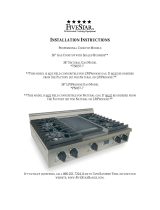
Step 2: Cabinet Preparation
I. To ensure professional results, the cabinet and
countertop openings should be prepared bya qualified
cabinet worker.
2. The clearances shown in Fig. I are required. The same
clearances apply to island installations, except for the
overhead cabinets, which must have a space wide
enough to accept the island hood.
3. The cooktop isdesigned to hang from the countertop by
its sideflanges. Thecountertop however, must bestrong
enoughtosupportthis heavycooktop. Itmaybe necessaq/
to add a supporting cleat along each side (see Fig. 2) or
a 2 x 4 corner brace (see Figs. 3 and 4 and Detail A).
Another alternative would be to construct a deck to set
the cooktop on.
4. The cooktop can be installed in various positions
with the front either flush or projecting, depending
on the countertop's depth. (See Fig. 5, side view of
cooktop; see Figs. 3,4, 6 and 7for alternate mounting
positions.)
5. The gas and electrical supply must be located in an
area that isaccessible without requiring removal ofthe
cooktop. The appliance electrical power cord and gas
pipe connection are located on the left rear underside
of the cooktop (except on models with a 24" griddle
where power cord is located in the center), as shown
in Figs. 5 and 9.
6. The maximum depth of over head cabinets installed
on either side of the hood is 13".
A 364nch minimum clearance is required between the top
of the cooktop and the bottom of an unprotected cabinet. A
364nch distance can be used when the bottom d thewood
or metal cabinet is protected by not less than I/4 inch d a
flame retardant material covered with not less than No. 28
MSG sheet steel, 0.015 inch (0A mm) thick stainless steel,
0.024 inch (0.6 ram)aluminum, or 0.020 inch (0.5 mm)thick
copper. Flame retardant materials bear the mark:
UNDERWRITERS LABORATORIES INC.
CLASSIFIED MINERAL AND FIBER BOARDS
SURFACE BURNING CHARACTERISTICS
followed by the flame spread and smoke ratings. These
designations are shown as "FHC (Flame Spread/Smoke
Developed)." Materials with "O" flame spread ratings
are flame retardant. Local codes may allow other flame
spread ratings.
7. When there is less than a 12" horizontal clearance
between combustible material A and the back edge
ofthe cooktop above thecooking sudace, a Thermador
Low Back backguard must be installed. (See Step 6).
When clearance to combustible material A isover
12", a Thermador Island Trim may be used. Attach
the backguard before sliding the appliance into the
final installed position.
8. Establish the centerline of the cooktop's desired
location. It should be the same as the center of the
overhead ventilation hood.
9. Cut the openings for the following installations:
• Wail installation, see Fig. 3.
• Island installation, see Fig. 4.
I0. For flush installations as shown in Fig. 7, provide
clearance for the three screws located along the
underside of the cooktop leading edge by increasing
the cutout height by 1/16" or by notching the cabinet
at the location of the three screws.
11. For models with a griddle, attach the foam strip to
countertop centered along the rear about 1/16" from
the edge.
12. For installation of a 48" cooktop above two side-by-
side Thermador Warming Drawers, Model No. WD24,
refer to Fig. 8. Completing the installation as per Fig.
8 will result in the left and right edges of the cooktop
being aligned with the left edge ofthe ieftosidewarming
drawer and rightedge tithe right-side warming drawer.
If different alignment is desired, the IW/8" horizontal
distance between warming drawer cutouts may be
varied. However, maintain at least a 1-I/8" distance
to avoid interference between the warming drawers.
Attach a 90-degree elbow to the gas cooktop inlet
pipe. All above4he-countertop clearances must be
maintained, as shown in Fig. I.
AAs defined in the "National Fuel Gas Code"
(ANSI Z223.1/NFPA54-current issue).
NOTES:
• If a solid side cabinet wall exists on one or both
sides, you will need to notch the front corner of the
cabinet to match the countertop notch and to allow
clearance for the cooktop front (see Detail A, Figs.
3 and 4).
• Ifa supporting deck isused, the sides or bottom ofthe
cutout may be solid combustible or noncombustible
material. If the bottom is solid, provide a 8" by 8"
cutout in the left rear corner of the supporting deck.
This will provide clearance for the gas inlet and power
cord, while also allowing viewing of the product rating
label.
• On models which have a 24" griddle with power
cord in the center, provide 2 (two) separate pieces
of supporting deck to allow clearance in center for
cord to pass through.
. Always keep appliance area clean and free from
combustible materials, gasoline and other flammable
vapors and liquids.
• Donotobstructthe flowofcombustion and ventilation
air to the unit.




















